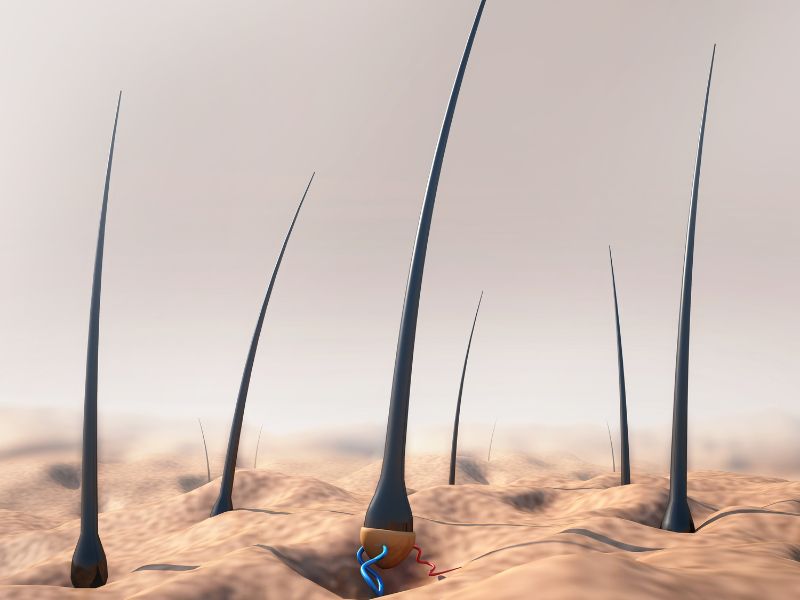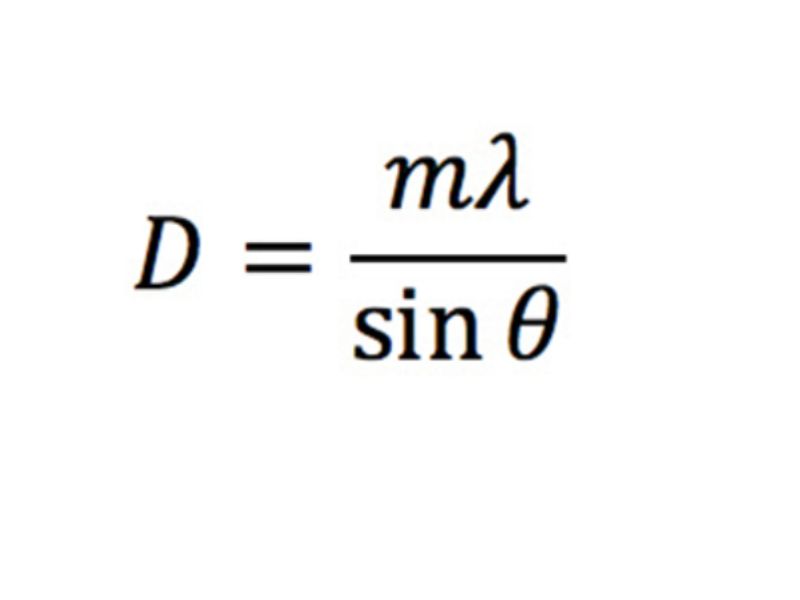Blog, Hair Extensions
Size of Human Hair – How to Measure It?
Everyone possesses their own unique lock – some have long and silky hair, others have thin but smooth. One thing for sure is that we all have our one-of-a-kind look, and no one is alike. Yet, have you ever wondering why are there such differences among how our locks? Today’s post will dig deeper into the size of a human hair so that you can have more idea about this problem.

Factors Involving The Size Of Human Hair
Human hair consists of 80% of keratin, which makes it the main constituent of hair, and roughly 10-15% of water. The other 5-10% are mainly pigments, minerals, and lipids. This diversity in human hair size is influenced by various genetic and environmental factors.
#1 Hair Follicles
One of the factors involving the size of human hair is hair follicles. The size of hair follicles, which includes the diameter of human hair, plays a crucial role in determining the thickness and overall appearance of your strands. Hair follicles, also known as hair root, is the cup-shaped part of your strands located under the scalp. Each hair follicle contains many tiny blood vessels.

Hair follicles are tightly attached to your scalp so that nutrients can follow the blood vessels to feed the tresses. An interesting fact for you is that the hair follicles are the only “living” part of the hairs that helps them grow.
#2 Hair Body
The hair body, or what you call it “tress”, is the visible part that you see every day. Unlike the follicle. This is the part of the hair that is “dead” and has no biochemical exchange (that’s why you won’t feel pain when chopping off your hair).
The size of human hair body can vary significantly from person to person, contributing to the diverse array of hairstyles and textures. Whether it’s the size of a human hair that’s fine and delicate or one that’s thick and robust, the hair body plays a significant role in our overall appearance.
The hair body consists of 3 layers: the cuticle, the cortex, and the medulla.
- Cuticle
The very outer layer of our strands is the cuticles, which envelop the core of the hair shaft – the hair cortex – each hair comprises about 15% cuticles and 80% cortex. Hair cuticles are often colorless and transparent. Observing the cells of the hair, we can see that the epidermis is made up of 6 to 10 layers of scales stacked on top of each other. While weak hair and light-colored hair have fewer scales, thicker and darker hair has more layers of flakes and is more closely connected with the epidermis to protect the hair as well as retain moisture.

In order to carry out the dyeing process, your hair cuticles must be opened for the dyeing solution to penetrate into the body of the hair, where the process of discoloration & oxidation takes place.
- Cortex
The cortex is the most resistant and important part of the hair. It makes up 80% of the hair’s structure and contains all the natural pigments or melanin that determine the color of the hair. The hair cortex is capable of containing small, dark and solid structure colored particles. They vary in color, size, and distribution.
- Medulla
The hair medulla is located in the hair shaft, the innermost part of your hair. The medulla is composed primarily of keratin that does not have a clear shape, size, and has no specific function.
The hair body consists of 3 layers: the cuticle, the cortex, and the medulla
Another surprising fact is that the density of one’s hair depends on what hair color they have. Which hair color you own is determined by two types of melanin: Eumelanin (natural pigment, brown to black) and Pheomelanin (red pigment). In general, the more Eumelanin, the darker the hair and vice versa.

Most times, the blondes are the ones who have the most hair. The runner-up is the black-haired with an average of 110,000 hairs each and the follow-ups are brunettes with 100,000 hairs and redheads with 80,000 hairs. Nevertheless, those are just numbers, the size of the hair, on the other hand, is a whole different aspect.
For example, black-haired people often get their strands thicker than those redheads and vice versa. That’s why we cannot actually place a standard value to human hair’s thickness as the genetic makeup differs from yours to that of the others.
Another factor that drives your hair size is age. The rate of melanin changes over time, so your hair color also changes with age. Your hair turns grey and white when you aged as a result of pigments loss. The older you become, the more the pigment decreases.
Our aging processes also greatly influence the keratin and KAP (keratin-associated proteins) expressions in the hair follicles. As we grow up, the strands become thicker and stronger, as they’re in their most well-balanced machinery.

Yet, once we passed our 20s, hair aging symptoms will start appearing as well. Each of us goes through 3 stages of developing hairs. The very first stage is when hairs start to grow and generated. We call it the anagen phase. The anagen phase will last between 2-7 years depending on each individual.
The second stage is the catagen phase, which is when follicles stop producing and thus causing the hair to shed. The final stage called the telogen phase. In this phase, hair follicles regenerate and new hair starts to form. This phase often occurs within 3 months or more.
The Average Size Of Human Hair
Human hairs are often measured with a specific measurement unit called micrometer (µm). Typically, the width of human hair ranges from 17 to 181 µm, not accounting for other factors that may affect hair texture and density. Having said that, this measurement can only be counted as a general observation.
As we have stated, genetic inherit factors play vital roles in deciding the thickness of our tresses. Understanding the size of human hair is crucial in recognizing the fascinating differences in our hair characteristics.
When considering the human hair width in inches, it’s interesting to note that in general, Africa has coarser hair with a diameter of 1/450 – 1/140 of an inch each strand. Meanwhile, in Europe, European hairs are claimed to be thin when 0.04 – 0.06 mm thick, which is roughly equivalent to 0.0016 to 0.0024 inches in human hair width, considered average when 0.06 – 0.08mm (approximately 0.0024 to 0.0032 inches in human hair width), and thick when having a diameter of 0.08-0.1 mm, approximately 0.0032 to 0.004 inches in human hair width.
Comparing to Europeans and Africans, Asian hair is considered the thickest among the three with the typical diameter between 0.08 to 0.12mm, roughly 0.0032 to 0.0047 inches in size of human hair in millimeters, making it a distinctive feature of Asian hair.
Methods To Measure The Size Of Human Hair
Now, let’s find out how to measure the size of human hair. For the simplest way to measure one’s hair size, just observe the roots from different angles. When you look at your scalp, you can get the overall look of your hair density as well as the texture of your lock. Comparing your tress with thread is another simple way to determine if you have thick hair or not.
For a more accurate number, you may want to use the laser pointer to get the width of your strand. This is how you do it:
- Step 1: Use a 6 inches-wide cardboard to make the holding frame for your hair. Cut a small rectangle of 0.4 inches wide and 1.5 inches tall inside it.
- Step 2: Take the hair you want to measure and tape it at the top and bottom of the frame running through the very middle of the rectangle.
- Step 3: In the darkroom, stand 3 feet away from a blank wall and hold up the frame. Use the laser pointer and light it at the wall to get the reflection of the trees.
- Step 4: Measure the distance from your hair to the wall in centimeters (advisable)
- Step 5: Check the light wavelength. Normally, a red laser pointer is about 650 nm, whereas the green one will be about 532. Measure the light scatter on the wall from the center of the dot to the first section where the light can no longer reach. And you’ll get the elements needed to figure out the size of your hair. Put those numbers in this equation below:

D – the width of the hair
λ – the wavelength of the laser beam
θ = s ÷ D – the angle with the straight-through position made by the minima
s – the distance from the center of the principal maximum to the first minimum
a – the distance from the slit to the screen
m – the minimum distance measured on the scatter
For instance,
Distance between hair and laser and wall: a = 180 cm
Laser wavelength: λ = 0.000065cm
Ave light scatter of the hairs: s = 2.2 cm
The minimum distance measured on the scatter: m=1cm
D = 0.0053182 (cm)
If your hair lies between 14-181 µm, then your hair’s in the safe zone. In that case, make sure to keep caring for your hair to maintain a healthy lock.

Conclusion
Now that we’ve provided you the methods and how to measure the size of human hair, it’s time you tried it yourself. If you’re looking to transform your hair with extensions, it’s crucial to understand your natural hair’s dimensions to select the perfect match. One excellent option for high-quality hair extensions is Apohair. As one of the best wholesale hair vendors, we offer an impressive range of products that cater to various preferences and styles. Contact Apohair today and unlock the full potential of your hair, experiencing the beauty and confidence that a perfect hair extension can provide.
Next article: All Things You Should Know About Vietnamese Hair












